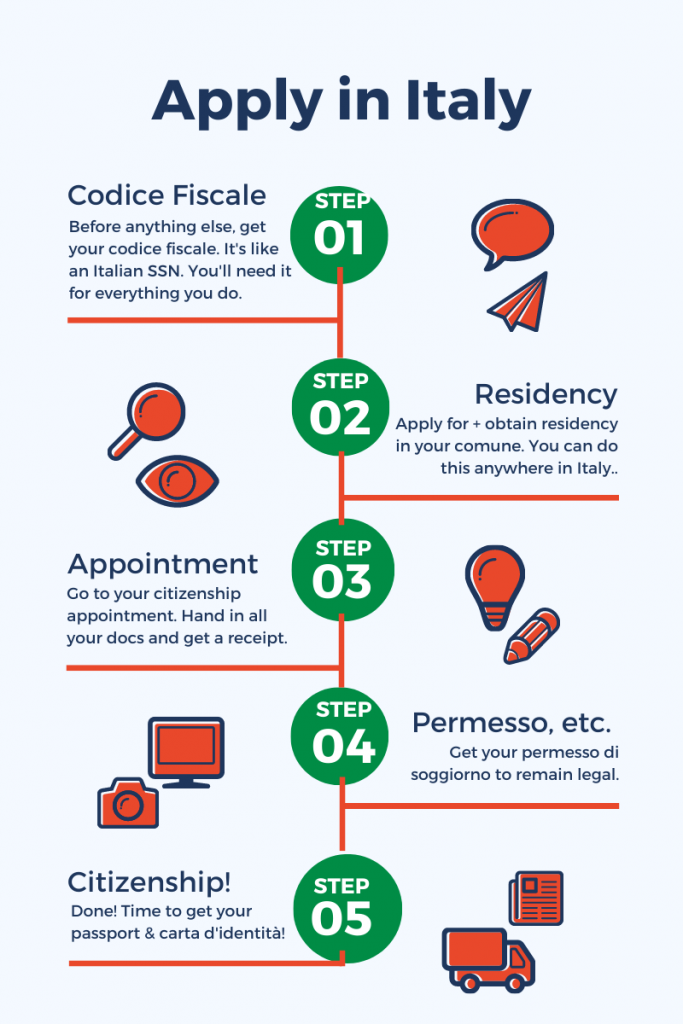
The Covid-19 pandemic has caused Italian consulates to pause their citizenship services. This has understandably exacerbated already-long wait times for recognition of Italian dual citizenship. As a result, many people can’t get an appointment at all. Others have found their appointment dates cancelled with no alternatives given.
This begs the question: can you expedite your Italian dual citizenship? The answer is yes.
In this post, we’ll go over the two most popular options for expediting your Italian dual citizenship application: applying directly in Italy and taking your case to court.
Let’s get started!
Italian citizenship can be a time-consuming endeavor
Italian dual citizenship is relatively simple to obtain. In terms of documentation required and ease of qualifying, there is nothing else like it in Europe. However, it can be time-consuming. Even simple cases may take two years or more. That’s just the reality of the current situation, even before the pandemic.
Those expediting their applications either in court or directly in Italy can shave off significant time. However, it is by no means a quick process. However, as with everything else in Italy, even with the expedited options citizenship is not automatic.
That said, there is a rule we always tell clients: time will pass anyway, so you might as well start on your application and forget about it. One day you’ll get a nice surprise and become an Italian citizen!
Now, let’s delve into the first option: skipping the consulate and applying directly in Italy.
[vcex_divider color=”#dddddd” width=”100%” height=”1px” margin_top=”20″ margin_bottom=”20″]
Expedite your Italian dual citizenship by applying in Italy

The most tried-and-true way to expedite your Italian dual citizenship.
If you can move to Italy for 6 months or more, this can be an excellent option. It’s also great for people already living in Italy for some other purpose such as studying or work. Finally, this option is excellent for those looking to “test out” living in Europe before making a permanent move.
Just like it sounds, applying in Italy involves physically moving to Italy and becoming a resident. You must be in Italy for a minimum of 6 months or more, as establishing residency involves showing a continued presence in your town.
Contrary to popular belief, you don’t have to apply in your ancestor’s city of birth. You can elect residency anywhere you want in Italy, as long as the comune is willing to accept your application.
In a perfect world, every single town in Italy would take dual citizenship applications at any time. But in reality, some are more hostile than others for various reasons (such as applications taking up too much time from their other work, office workers not wanting to deal with people who may not speak Italian, or them simply not knowing the process in depth and not caring to learn etc.). It’s a good idea to call or e-mail beforehand to get a feel for the town. If possible, even visit in person! Additionally, if a town has a website dedicated to the Italian dual citizenship process, it’s a good sign they are a “friendly” one.
Some friendly towns at the time of this writing include Bologna, Reggio Emilia, Rome, and Turin.
This option has been around for more than a decade. Traditionally it was popular with people from South America. Lately, more and more people from the United States are opting to do this too. Take the information below with a grain of salt, as processes may vary from comune to comune and rules are always changing. However, this is a general guide that can be applicable in most cases.
[vcex_divider color=”#dddddd” width=”100%” height=”1px” margin_top=”20″ margin_bottom=”20″]
Step 1: Obtaining a codice fiscale
Before anything else, you must go to any Agenzia delle Entrate (Italian revenue agency) and obtain a codice fiscale. This is a unique code issued just for you, kind of like a U.S. social security number. To get it, bring your passport showing date of entry into Italy. You’ll also have to fill in a form while you wait. There is no cost.
If you live in Europe already, you can obtain this before entering Italy by requesting one from your local Italian consulate. Italian consulates in the United States do not issue codici fiscali.
Step 2: Election of residency
Election of residency in Italy is a formal process that is unlike anything in the United States. Before anything else, you have to obtain a valid rental contract (contratto d’affitto), a declaration of hospitality (dichiarazione di ospitalità) from a landlord or friend, or a comodato d’uso contract. Then, you’ll fill in a residency request form and hand it in at your local anagrafe office. This will trigger a visit by the local officers (vigili) to confirm the applicant is actually living where they say they are. This visit must occur within 45 days, so be sure to stick around town during this time.
If all goes well, the town will confirm residency and places you within its APR (anagrafe popolo residente), the registry of residents.
Step 3: The citizenship appointment
Only after the officer has visited an applicant’s home can they then apply for recognition of Italian citizenship. This involves an appointment with either the ufficio di stato civile or the ufficio cittadinanza depending on the size of the comune. Much like at a consular appointment, applicants will hand in their supporting documents. Then, they receive a receipt that the citizenship process has started.
Step 4: Permesso di soggiorno
Finally, the applicant compiles a paperwork kit for a permesso di soggiorno in attesa di cittadinanza. These kits are available at post offices throughout Italy. This type of permesso di soggiorno is a special one because it is only for those seeking recognition of Italian citizenship jure sanguinis. It allows applicants to stay in Italy legally past 90 days.
Once the kit is compiled, applicants bring it along with the receipt of handing in citizenship paperwork to the post office. While there, they hand the kit + receipt in along with payment. A slip of paper will automatically be generated, along with a date. This is the day the applicant must show up to the questura (precinct) to request the actual permesso. However, if an applicant becomes a citizen before the date on the receipt for the permesso, they can let the date lapse and not request the permesso.
Step 5: Official recognition of citizenship
After the applicant hands in all citizenship-related documents, the comune will take scans of all records. Then, they will send those scans to the consulate(s) back home with jurisdiction over all the places the applicant has lived. The consulate(s) must confirm that the applicant has never renounced the right to Italian dual citizenship.
Once the consulate(s) have responded with the go ahead, the comune will issue an official letter recognizing the applicant as an Italian citizen.
Step 6: Birth certificate transcription
This is the final step in confirming a person’s Italian dual citizenship. Once recognized, an applicant’s U.S. birth certificate is transcribed into Italian and placed in the registry of the comune in which s/he lives. This is the final, absolute proof of Italian citizenship.
Step 7: Passport, carta d’identità and tessera sanitaria
Armed with an Italian birth certificate and Italian residency, the newly minted Italian citizen can obtain a few things. This includes:
- An Italian passport;
- A carta d’identità (Italian identity card) listing “Italian” as the nationality;
- A tessera sanitaria (health card), though this can also be done before recognition of citizenship and after confirmation of residency.
All told, applying in Italy may take up anywhere from 3 to 12 months, depending on complexity of your case.
[vcex_divider color=”#dddddd” width=”100%” height=”1px” margin_top=”20″ margin_bottom=”20″]
Expedite your Italian dual citizenship by applying in court

Italian dual citizenship can be daunting, not only in terms of paperwork but also due to dealing with the consulates. Those in the United States are now only beginning to experience the long wait times and lack of appointments that have plagued consulates in South America for decades.
Applying via court is an excellent way to expedite your Italian dual citizenship if you cannot move to Italy.
A delayed process
Many consulates have multi-year waits for appointments, and then take 2 or 3 years to even process the applications thereafter. All told, it is not unheard of for someone to wait 5-6 years for recognition of Italian citizenship from a consulate.
However, many people don’t have the time to wait. And, according to Italian law, they don’t have to. Both the European Union Charter of Fundamental Rights (legally binding on EU institutions and Member States) as well as the Constitution of the Italian Republic enshrine the princple of due process. This means that everyone has the right to have his or her affairs handled fairly, impartially, and within a reasonable time frameItalian law states that consulates must make decisions on Italian citizenship applications within 730 days from the date of said application (Article 2 of the Italian Administrative Process Act no. 241/1990 and the President of the Council of Ministers’ Decree no. 33/2014). Most Italian consulates this rule arbitrarily. They claim that the 730 day window starts from the date in which the consulate starts processing an applicant’s file.
Taking it to court
However, this interpretation does not hold up in court.
The Court of Rome (which decides on all disputes regarding Italian citizenship applications) has consistently ruled that the 730 day deadline starts from the date in which the applicant requests an appointment of the consulate to file a citizenship claim. Therefore, all those who obtain an appointment that is more than 730 days in the future (or those who can prove there are no appointments available) have a legitimate claim that their rights to due process are violates under Italian and European Union law. Therefore, they can seek recognition of Italian dual citizenship from the Court of Rome rather than the consulate.
Steps involved in a citizenship proceeding before the Court of Rome
When your case goes before the court, it is considered a “paper” proceeding. This means that the judge will look at your paperwork and no other type of testimony (experts, witnesses, etc.) are admissible. In the vast majority of cases, citizenship proceedings only involve one hearing in which your attorney and the judge go through your paperwork to track your claim for citizenship.
Before anything else, the attorney files your lawsuit in the Court of Rome. This contains the summons and all documents gathered proving your claim to Italian citizenship. Your are the plaintiff and the Italian Ministry of the Interior is the defendant.
Then, this happens:
- The President of the Court appoints the court which will hear your claim.
- A few months later, the court appoints a judge.
- The judge issues a decree to set your hearing date.
- Your attorney serves the summons and the decree to the Ministry of the Interior.
- The Ministry has 10 days to respond before the date of appearance. Rarely, if ever, does the Ministry respond.
- At the hearing, the judge hears the case and goes over your paperwork. At this point if she or he requires more paperwork, your attorney will tell you. If the paperwork is sufficient, the judge closes the case and will rule by issuing a Citizenship Ordinance.
- Your attorney will serve the Citizenship Ordinance to the Ministry of the Interior to cut the deadline for response down from 6 months to 1 month.
- The court serves the ordinance to the public prosecutor who has 2 months to appeal.
- Once all deadlines have passed, the attorney will request a formal, irrevocable copy of the Citizenship Ordinance.
- The attorney requests the court to release the executable Citizenship Ordinance.
- Your attorney will issue the executable ordinance to your ancestor’s comune, compelling them to record you (and your family members) there as recognized citizens.
- The comune will transcribe your (and your family members’) birth certificate into Italian and officially place it on file in their records.
- You can enroll in AIRE and obtain an Italian passport.
All told, the process by court may take 12-36 months, depending on complexity of your case.
Do you want to expedite your Italian dual citizenship? Talk to us today! Send us an e-mail at hello@getitaliancitizenship.com for more information about how we can help you.
